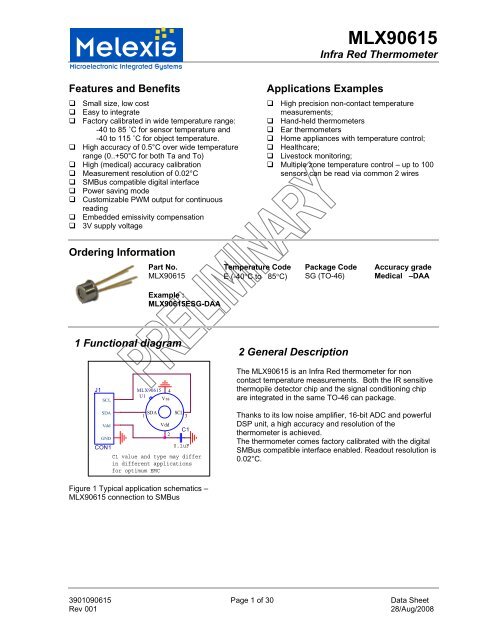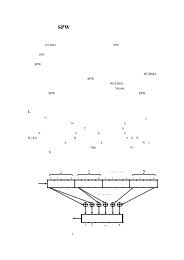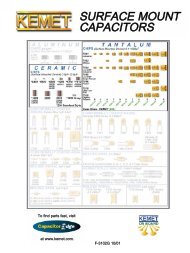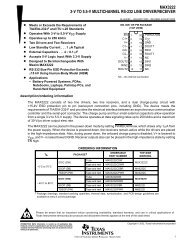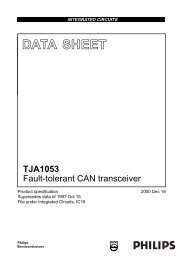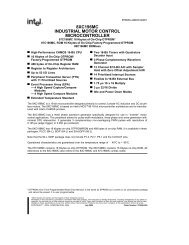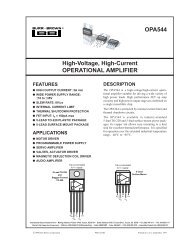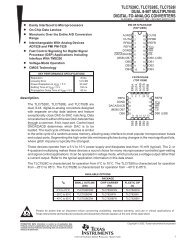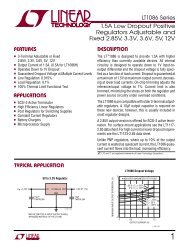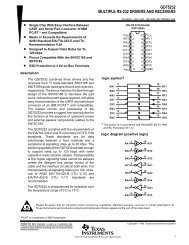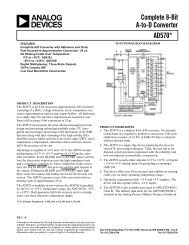MLX90615
MLX90615
MLX90615
- No tags were found...
You also want an ePaper? Increase the reach of your titles
YUMPU automatically turns print PDFs into web optimized ePapers that Google loves.
<strong>MLX90615</strong>Infra Red ThermometerFeatures and Benefits Small size, low cost Easy to integrate Factory calibrated in wide temperature range:-40 to 85 ˚C for sensor temperature and-40 to 115 ˚C for object temperature. High accuracy of 0.5°C over wide temperaturerange (0..+50°C for both Ta and To) High (medical) accuracy calibration Measurement resolution of 0.02°C SMBus compatible digital interface Power saving mode Customizable PWM output for continuousreading Embedded emissivity compensation 3V supply voltageApplications Examples High precision non-contact temperaturemeasurements; Hand-held thermometers Ear thermometers Home appliances with temperature control; Healthcare; Livestock monitoring; Multiple zone temperature control – up to 100sensors can be read via common 2 wiresOrdering InformationPart No.<strong>MLX90615</strong>Temperature CodeE (-40°C to 85°C)Package CodeSG (TO-46)Accuracy gradeMedical –DAAExample :<strong>MLX90615</strong>ESG-DAA1 Functional diagram2 General DescriptionJ1SCL<strong>MLX90615</strong> 4U1VssThe <strong>MLX90615</strong> is an Infra Red thermometer for noncontact temperature measurements. Both the IR sensitivethermopile detector chip and the signal conditioning chipare integrated in the same TO-46 can package.SDAVddGNDCON1SDA SCL13VddC120.1uFC1 value and type may differin different applicationsfor optimum EMCThanks to its low noise amplifier, 16-bit ADC and powerfulDSP unit, a high accuracy and resolution of thethermometer is achieved.The thermometer comes factory calibrated with the digitalSMBus compatible interface enabled. Readout resolution is0.02°C.Figure 1 Typical application schematics –<strong>MLX90615</strong> connection to SMBus3901090615 Page 1 of 30 Data SheetRev 00128/Aug/2008
<strong>MLX90615</strong>Infra Red ThermometerGeneral description (continued)The <strong>MLX90615</strong> is built from 2 chips, the Infra Red thermopile detector and the signal conditioning chipMLX90325, specially designed by Melexis to process the output of IR sensor.The device is available in an industry standard TO-46 package.Thanks to the low noise amplifier, high resolution 16-bit ADC and powerful DSP unit of the MLX90325,Melexis is able to deliver a high accuracy and high resolution infrared thermometer. The calculated objectand ambient temperatures are available in the RAM memory of the MLX90325 with a resolution of 0.02 ˚C.The values are accessible by 2 wire serial SMBus compatible protocol with a resolution of 0.02°C or via a 10-bit PWM (Pulse Width Modulated) signal from the device.The <strong>MLX90615</strong> is factory calibrated in standard temperature ranges from: -40 to 85˚C for the ambienttemperature and from -40 to 115˚C for the object temperature.As a standard, the <strong>MLX90615</strong> is delivered with a programmed object emissivity of 1. It can be easilycustomized by the customer for any other emissivity in the range 0.1-1.0 without the need of recalibration witha black body.The <strong>MLX90615</strong> can be battery powered.An optical filter (5.5µm to 14µm long-wave pass) that cuts off the visible and near infra-red radiant flux isintegrated in the package to make the sensor insensitive to visible light.3901090615 Page 2 of 30 Data SheetRev 00128/Aug/2008
<strong>MLX90615</strong>Infra Red Thermometer3 Table of Contents1 Functional diagram......................................................................................................................................................................................12 General Description ....................................................................................................................................................................................1General description (continued).....................................................................................................................................................................23 Table of Contents........................................................................................................................................................................................34 Glossary of Terms.......................................................................................................................................................................................45 Maximum ratings.........................................................................................................................................................................................46 Pin definitions and descriptions ..................................................................................................................................................................57 Electrical Specifications ..............................................................................................................................................................................68 Detailed description.....................................................................................................................................................................................88.1 Block diagram......................................................................................................................................................................................88.2 Signal processing principle..................................................................................................................................................................88.3 Block description .................................................................................................................................................................................88.3.1 Amplifier .......................................................................................................................................................................................88.3.2 Power-On-Reset (POR) ...............................................................................................................................................................98.3.3 EEPROM......................................................................................................................................................................................98.3.4 RAM ...........................................................................................................................................................................................108.4 SMBus compatible 2-wire protocol....................................................................................................................................................108.4.1 Functional description ................................................................................................................................................................108.4.2 Differences with the standard SMBus specification (reference [1]) ...........................................................................................118.4.3 Detailed description....................................................................................................................................................................118.4.4 AC specification for SMBus .......................................................................................................................................................138.4.5 Bit transfer..................................................................................................................................................................................148.4.6 Commands.................................................................................................................................................................................148.4.7 Sleep Mode................................................................................................................................................................................148.5 Switching between PWM and SMBus ...............................................................................................................................................158.5.1 PWM is enabled.........................................................................................................................................................................158.5.2 Request condition ......................................................................................................................................................................168.5.3 PWM is disabled ........................................................................................................................................................................168.6 PWM..................................................................................................................................................................................................178.6.1 PWM format ...............................................................................................................................................................................178.6.2 Customizing the temperature range for PWM output.................................................................................................................188.7 Principle of operation.........................................................................................................................................................................198.7.1 Ambient temperature Ta ............................................................................................................................................................198.7.2 Object temperature To ...............................................................................................................................................................199 Unique Features........................................................................................................................................................................................2010 Performance Graphs...............................................................................................................................................................................2010.1 Temperature accuracy of the <strong>MLX90615</strong> ........................................................................................................................................2010.2 Field Of View (FOV) ........................................................................................................................................................................2111 Applications Information..........................................................................................................................................................................2211.1 Use of the <strong>MLX90615</strong> thermometer in SMBus configuration ..........................................................................................................2211.2 Use of multiple <strong>MLX90615</strong>s in SMBus configuration.......................................................................................................................2211.3 PWM output.....................................................................................................................................................................................2312 Application Comments ............................................................................................................................................................................2413 Standard information regarding manufacturability of Melexis products with different soldering processes............................................2514 ESD Precautions.....................................................................................................................................................................................2615 FAQ.........................................................................................................................................................................................................2616 Package Information ...............................................................................................................................................................................2817 References..............................................................................................................................................................................................2918 Disclaimer ...............................................................................................................................................................................................293901090615 Page 3 of 30 Data SheetRev 00128/Aug/2008
<strong>MLX90615</strong>Infra Red Thermometer4 Glossary of TermsPTATPORHFODSPFIRIIRIRDCLPFFOVSDA,SCLTaToESDEMCTBDProportional To Absolute Temperature sensor (package temperature)Power On ResetHigh Frequency Oscillator (RC)Digital Signal ProcessingFinite Impulse Response. Digital filterInfinite Impulse Response. Digital filterInfra-RedDirect Current (for settled conditions specifications)Low Pass FilterField Of ViewSerial Data, Serial CLock – SMBus compatible communication pinsAmbient Temperature measured from the chip – (the package temperature)Object Temperature, ‘seen’ from IR sensorElectro-Static DischargeElectro-Magnetic CompatibilityTo Be Defined5 Maximum ratingsParameter.<strong>MLX90615</strong>Supply Voltage, VDD (over voltage)5VSupply Voltage, VDD (operating)3.6 VReverse Voltage0.5 VOperating Temperature Range, TA-40…+85°CStorage Temperature Range, TS-40…+125°CESD Sensitivity (AEC Q100 002)2kVDC sink current, SDA pin25 mADC clamp current, SDA pin10 mADC clamp current, SCL pin10 mATable 1: Absolute maximum ratings for <strong>MLX90615</strong>Exceeding the absolute maximum ratings may cause permanent damage. Exposure to absolute-maximumratedconditions for extended periods may affect device reliability.3901090615 Page 4 of 30 Data SheetRev 00128/Aug/2008
<strong>MLX90615</strong>Infra Red Thermometer6 Pin definitions and descriptions2 - VDD3 - SCL1 - SDA/PWM4 – VSSand caseTop viewFigure 2: Pin description <strong>MLX90615</strong>Pin NameVSSSCLSDA/PWMFunctionGround. The metal can is also connected to this pin.Serial clock input for 2 wire communications protocol. Weak pullup(300kΩ typ) is present on this pin.Digital input / output open drain NMOS. In SMBus mode (factorydefault) Serial Data I/O. In PWM mode – PWM output. Weak pullup(300kΩ typ) is present on this pin.VDD External supply voltage.Table 2: Pin description <strong>MLX90615</strong>Notes:For EMC and isothermal conditions reasons, it is highly recommended not to use any electrical connection tothe metal can except by the Vss pin.The SDA pin is an input Schmidt trigger when the thermometer is operated in the 2-wire SMBus interfacemode.3901090615 Page 5 of 30 Data SheetRev 00128/Aug/2008
<strong>MLX90615</strong>Infra Red Thermometer7 Electrical SpecificationsAll parameters are preliminary for T A = 25 ˚C, V DD =3V (unless otherwise specified)Parameter Symbol Test Conditions Min Typ Max UnitsSuppliesExternal supply V DD 2.6 3 3.6 VSupply current I DD No load 0.8 1.5 mASupply current(programming)Power-down supplycurrentPOR levelI DDprNo load, erase/write EEPROMoperations1.5 mAIsleep No load, SCL and SDA high 1.1 3 µAV PORPower On ResetPower-up, power-down andbrown-out0.8 1.5 1.9 VV DD rise time T POR Ensure POR signal 20 msOutput valid Tvalid After POR 0.5 sEEPROMData retention Ta = +85°C 10 yearsErase/write cycles Ta = +25°C 100,000 TimesErase/write cycles Ta = +85°C 40,000 TimesErase cell time Terase 5 msWrite cell time Twrite 5 msPulse width modulationPWM resolution PWMres Data band 10 bitPWM output periodPWM T,H,defFactory default high frequencyPWM, HFO factory calibrated1.024 msPWM output periodPWM T,LLow frequency PWM,HFO factory calibrated102.4 msPWM period stabilitydPWM TInternal oscillator factorycalibrated, over the entireoperation range and supplyvoltage-15 +15 %Output low Level PWM LO I sink = 2 mA 0.2 VOutput sink current Isink PWM Vout,L = 0.5V 10 mA3901090615 Page 6 of 30 Data SheetRev 00128/Aug/2008
<strong>MLX90615</strong>Infra Red ThermometerParameter Symbol Test Conditions Min Typ Max UnitsSMBus compatible 2-wire interface *Input high voltage V IH 1.6 2 2.4 VInput high voltage V IH(Ta,V) Over temperature and supply 1.2 2 2.8 VInput low voltage V IL 0.7 1.0 1.3 VInput low voltage V IL(Ta,V) Over temperature and supply 0.5 1.0 1.5 VOutput low voltageV OLOver temperature and supply, Isink= 2mA0.2 VSCL,SDA leakage I leak V SCL=V DD, V SDA=V DD, Ta=+85°C 0.25 uASCL capacitance C SCL 10 pFSDA capacitance C SDA 10 pFSlave address SA Factory default 5Bh hexSMBus Request t REQ SCL low 21 39 msTimeout,low T imeout,L SCL low 27 32 39msTimeout, high T imeout,H SCL high 52 64 78 usAcknowledge setup time Tsuac(MD) 8-th SCL falling edge, Master TBD usAcknowledge hold time Thdac(MD) 9-th SCL falling edge, Master TBD usAcknowledge setup time Tsuac(SD) 8-th SCL falling edge, Slave TBD usAcknowledge hold time Thdac(SD) 9-th SCL falling edge, Slave TBD usNotes: All the communication and refresh rate timings are given for the nominal calibrated HFO frequency and will varywith this frequency’s variations.*SMBus compatible interface is described in details in the SMBus detailed description section. Maximum number of<strong>MLX90615</strong> devices on one bus is 127, higher pullup currents are recommended for higher number of devices, faster busdata transfer rates, and increased reactive loading of the bus.<strong>MLX90615</strong> is always a slave device on the bus. <strong>MLX90615</strong> can work in both low-power and high-power SMBuscommunication.All voltages are with respect to the Vss (ground) unless otherwise noted.3901090615 Page 7 of 30 Data SheetRev 00128/Aug/2008
<strong>MLX90615</strong>Infra Red Thermometer8 Detailed description8.1 Block diagramIR sensorOPAADCFIR/IIRfiltersSMBus /PWMt°DSP<strong>MLX90615</strong>MLX90325VoltageReferenceFigure 3: block diagram8.2 Signal processing principleA DSP embedded in the <strong>MLX90615</strong> controls the measurements, calculates object and ambient temperaturesand does the post-processing of the temperatures to output them through SMBus compatible interface orPWM (whichever activated).The output of the IR sensor is amplified by a low noise, low offset chopper amplifier with programmable gain,then converted by a Sigma Delta modulator to a single bit stream and fed to the DSP for further processing.The signal passes a FIR low pass filter. The output of the FIR filter is the measurement result and is availablein the internal RAM. Based on results of the above measurements, the corresponding ambient temperatureT a and object temperatures T o are calculated. Both calculated temperatures have a resolution of 0.02 ˚C.An additional IIR LPF is programmable in EEPROM and allows customization of the thermometer output inorder to trade-off noise versus measurement speed . The IIR filter can also limit effect of spurious objects thatmay appear in the FOV in some applications.The PWM output can be enabled in EEPROM as the POR default. Linearized temperatures (To or Ta,selectable in EEPROM) are available through the free-running PWM output.8.3 Block description8.3.1 AmplifierA low noise low offset amplifier with programmable gain is implemented for amplification of the IR sensorvoltage. With a carefully designed input modulator and balanced input impedance, an offset as low as 0.5µVis achieved.3901090615 Page 8 of 30 Data SheetRev 00128/Aug/2008
<strong>MLX90615</strong>Infra Red Thermometer8.3.2 Power-On-Reset (POR)The Power On Reset (POR) is connected to the Vdd supply. The on-chip POR circuit provides an active levelof the POR signal when the Vdd voltage rises above approximately 0.5V and holds the entire <strong>MLX90615</strong> inreset until the Vdd is higher than the specified POR threshold V POR . During the time POR is active, the PORsignal is available as a weak open drain (active high) at the SDA pin. After the <strong>MLX90615</strong> exits the PORstate, the functions programmed in the EEPROM take control of that pin.8.3.3 EEPROMA limited number of addresses in the EEPROM memory are of interest for the customer. The whole EEPROMcan be read and written with the SMBus interface.The entire EEPROM content between addresses 4h andDh must be kept unaltered or the factory calibration of the device will be lost.EEPROM (16X16)Name Address Write accesSMBus slave address (SA) / PWM T min 0h YesPWM T range 1h YesConfig 2h YesEmissivity 3h YesMelexis reserved (factory calibration) 4h Yes… … …Melexis reserved (factory calibration) Dh YesID number Eh NoID number Fh NoSMBus slave address: 7 LSBs (6..0) contains the SMBus slave address that the <strong>MLX90615</strong> will respond to.Note that all <strong>MLX90615</strong> will respond to SA 00h and therefore this value is useless in a network. Factorydefault is 5Bh.PWM T min: 15 bit limit for the PWM signal minimum temperature – right justified (factory default is 355Bh,which corresponds to +0.03°C)PWM T range: 15 bit range for the PWM signal temperature (Tmax – Tmin) – right justified (factory default is09C3h, which corresponds to a PWM range +0.03…+50.01°C).The Config register consist of control bits to configure the thermometer at POR:Bit number Factory default value FunctionBit 0 1 SMBus/ PWM mode select 1 – SMBus 0 - PWMBit 1 0 PWM frequency (doesn’t 1 - Low 0 - Highmatter in SMBus mode)Bit 2 0 PWM output temperature 1 - Ta 0 - ToBit [11:3] Device specific Factory calibration do not alterBits [14:12] 001b IIR settings*Bit [15] 0 Must be kept 0IIR setting atEEPROM address 02h[binary]Settling time[samples]Spike response%001 1 100010 10 50011 18 33.(3)100 24 25101 31 20110 38 16.(6)111 45 14.286*Note: IIR setting 000b must be avoided3901090615 Page 9 of 30 Data SheetRev 00128/Aug/2008
<strong>MLX90615</strong>Infra Red ThermometerEmissivity: Contains the value for object emissivity correction. The <strong>MLX90615</strong> will compensate for theemissivity of the object measured with respect to that value. The equation for that register isEmissivity = dec2hex[round(16384 x ε)],where dec2hex[round(X)] represents decimal to hexadecimal conversion with round-off to nearestvalue (not truncation). In this case the physical emissivity values are ε 0…1. For details about the emissivityfactor in IR measurements refer to the FAQ section of the current document.Factory default is 4000h, which sets the thermometer to an emissivity of 1.0 (emissivity correction off).8.3.4 RAMRAM can be read through SMBus interface. Limited number of RAM registers, summarized below are ofinterest to the customer.RAM (16x16)Name Address Read accessMelexis reserved 0h Yes… … …Melexis reserved 4h YesRaw IR data 5h YesT A 6h YesT O 7h YesMelexis reserved 8h Yes… … …Melexis reserved Fh YesT A is the <strong>MLX90615</strong> package (ambient) temperature and T O is the object temperature. The output scale is0.02°K/LSB. To convert a read object temperature into degrees Celsius the equation isTo [°C] = RAM(7h)*0.02 – 273.15.Raw IR data is in sign (1 bit, the MSB) and magnitude (15 bits) format.8.4 SMBus compatible 2-wire protocolThe chip supports a 2 wires serial protocol, build with pins SDA and SCL.• SCL – digital input, used as the clock for SMBus compatible communication. A low pulse on that pinwith duration t REQ switches to the SMBus mode in case the PWM is selected in EEPROM. In casePWM operation is desired, the SCL pin should be kept high. SMBus is the factory default (viaEEPROM settings).• SDA/PWM – Digital input/ NMOS open drain output, used for both PWM and input/output for theSMBus. (SMBus is factory default function).8.4.1 Functional descriptionThe SMBus interface is a 2-wire protocol, allowing communication between the Master Device (MD) and oneor more Slave Devices (SD). In the system only one master can be present at any given time [1]. The<strong>MLX90615</strong> can only be used as a slave device.Generally, the MD initiates the start of data transfer by selecting a SD through the Slave Address (SA).The MD has read access to the RAM and EEPROM and write access to 14 EEPROM cells (at addresses0..Dh). If the access to the <strong>MLX90615</strong> is a read operation, it will respond with 16 data bits and 8 bit PEC onlyif its own slave address, programmed in the internal EEPROM, is equal to the SA, sent by the master. TheSA feature allows connecting up to 127 devices with 2 wires, unless the system has some of the specificfeatures described in paragraph 5.2 of reference [1]. In order to provide access to any device or to assign anaddress to a SD before it is connected to the bus system, the communication must start with zero SAfollowed by low RWB bit. When this command is sent from the MD, the <strong>MLX90615</strong> will always respond andwill ignore the internal chip code information.Note that EEPROM addresses 4h…Dh contain the factory calibration and should not be altered.3901090615 Page 10 of 30 Data SheetRev 00128/Aug/2008
<strong>MLX90615</strong>Infra Red ThermometerSpecial care must be taken not to put two <strong>MLX90615</strong> devices with the same SD addresses on thesame bus as <strong>MLX90615</strong> does not support ARP[1].The MD can force the <strong>MLX90615</strong> into low consumption mode “sleep mode”.8.4.2 Differences with the standard SMBus specification (reference [1])There are eleven command protocols for the standard SMBus interface. The <strong>MLX90615</strong> supports only two ofthem. Not supported commands are:• Quick Command• Byte commands - Sent Byte, Receive Byte, Write Byte and Read Byte• Process Call• Block commands – Block Write and Write-Block Read Process CallSupported commands are:• Read Word• Write Word8.4.3 Detailed descriptionThe SDA pin of the <strong>MLX90615</strong> can operate also as a PWM output, depending on the EEPROM settings. IfPWM is enabled, after POR the SDA pin is directly configured as a PWM output. The PWM mode can beavoided and the pin can be restored to its Serial Data function by issuing SMBus request condition. If SMBusis the POR default, the request does not have to be sent.SCLt REQSDA/PWMPWMStartSMBusStopFigure 4: SMBus request, start and stop conditionsAll conditions on the SCL and SDA/PWM lines are described in detail below.3901090615 Page 11 of 30 Data SheetRev 00128/Aug/2008
<strong>MLX90615</strong>Infra Red Thermometer8.4.3.1 Bus Protocol1 7 1 1 8 1 1SSlave Address Wr A Data Byte A PSSrStart ConditionRepeated Start ConditionRd Read (bit value of 1)Wr Write (bit value of 0)APPECAcknowledge (this bit can be 0 for ACK and 1 for NACK)Stop ConditionPacket Error CodeMaster-to-SlaveSlave-to-MasterFigure 5: SMBus packet element keyAfter every 8 bits received by the SD an ACK/NACK takes place. When a MD initiates communication, it firstsends the address of the slave and only the SD which recognizes the address will ACK the rest will remainsilent. If the SD NACKs one of the bytes, the MD should stop the communication and repeat the message. ANACK could be received after the PEC. This means that there is an error in the received message and theMD should try sending the message again. The PEC calculation includes all bits except the START,REPEATED START, STOP, ACK, and NACK bits. The PEC is a CRC-8 with polynomial X8+X2+X1+1. TheMost Significant Bit of every byte is transmitted first.8.4.3.1.1 Read Word (depending on the command – RAM or EEPROM)1 7 1 1 8 1 1 7 1S Slave Address Wr A Command A Sr Slave Address Rd1A………..………..8 1 8 1 8 1 1Data Byte Low A Data Byte High A PEC A PFigure 6: SMBus read word format3901090615 Page 12 of 30 Data SheetRev 00128/Aug/2008
<strong>MLX90615</strong>Infra Red Thermometer8.4.3.1.2 Write Word (EEPROM only)1 7 1 1 8 1S Slave Address Wr A Command A………..8 1 8 1 8 1 1……….. Data Byte Low A Data Byte High A PEC A PFigure 7: SMBus write word formatNote: Before a write operation takes place, the EEPROM cell needs to be erased. An erase operation issimply a write of 0000h at the same EEPROM address. Care needs to be taken not to alter factory calibration(EEPROM addresses 4…Dh).8.4.4 AC specification for SMBus8.4.4.1 TimingThe <strong>MLX90615</strong> meets all the timing specifications of the SMBus [1] except the values given in the Electricalspecifications section. The maximum frequency of the <strong>MLX90615</strong> SMBus clock is 100kHz and the minimumis 10kHz.The specific timings for the <strong>MLX90615</strong>’s SMBus are:SMBus Request (tREQ ) is the time that the SCL should be forced low in order to switch <strong>MLX90615</strong> fromthermal relay mode to SMBus mode;Timeout L is the maximum allowed time for SCL to be low. After this time the <strong>MLX90615</strong> will reset itscommunication block and will be ready for new communication;Timeout H is the maximum time for which it is allowed for SCL to be high during communication. After thistime <strong>MLX90615</strong> will reset its communication block assuming that the bus is idle (according to the SMBusspecification).Tsuac(SD) is the time after the eighth falling edge of SCL during which the <strong>MLX90615</strong> will force SDA low toacknowledge the last received byte.Thdac(SD) is the time after the ninth falling edge of SCL during which the <strong>MLX90615</strong> will release the SDA (sothe MD can continue with the communication).Tsuac(MD) is the time after the eighth falling edge of SCL during which the <strong>MLX90615</strong> will release SDA (sothat the MD can acknowledge the last received byte).Thdac(MD) is the time after the ninth falling edge of SCL during which the <strong>MLX90615</strong> will take control of theSDA (so it can continue with the next byte to transmit).The indexes MD and SD for the latest timings are used – MD when the master device is making theacknowledge; SD when the slave device is making the acknowledge). For other timings see [1].Timeout,LTsuacThdacTimeout,HSCLPWM/SDAFigure 8: SMBus timing3901090615 Page 13 of 30 Data SheetRev 00128/Aug/2008
<strong>MLX90615</strong>Infra Red Thermometer8.4.5 Bit transferSamplingdataChangingdataSCLPWM/SDAFigure 9: Bit transfer on SMBusThe data on SDA must be changed when SCL is low (min 300ns after the falling edge of SCL). The data isfetched by both MD and SDs on the rising edge of the SCL.8.4.6 CommandsIn application mode RAM and EEPROM can be read both with 16x16 sizes. (For example, T OBJ - RAMaddress 0x07h will sweep between 0x2D8Ah to 0x4BD0h as the object temperature rises from -40°C to+115°C). The MSB read from RAM is an error flag (active high) for the linearized temperatures (T OBJ and T a ).Opcode Command0001 aaaa* EEPROM Access0010 aaaa* RAM Access1100_0110 Enter SLEEP modeNote*: The aaaa are the 4 LSBits of the memory map address to be read/written.8.4.7 Sleep ModeSleep mode is available in SMBus mode only.<strong>MLX90615</strong> can enter Sleep Mode via command “Enter SLEEP mode” sent via the SMBus interface.<strong>MLX90615</strong> goes back into power-up default mode by forcing the SCL pin low for at least t DDq = 50 ms. Exitfrom Sleep is always in SMBus mode. Valid data will be available typically 0.3 seconds after the device haswoken up.Note: The previous generation IR thermometer, MLX90614 wakes up through a low pulse on the SDA line,not SCL.SCLt DDQSDA/PWMSleep commandStopSleepWake-upNormal operationFigure 10: Enter and exit Sleep3901090615 Page 14 of 30 Data SheetRev 00128/Aug/2008
<strong>MLX90615</strong>Infra Red ThermometerFigure 11: Detailed Sleep commandSCL needs to be high during Sleep. SDA can idle in each state at the same time, but the high state isrecommended as the pull-up does not add current drain. There are weak pull-ups on both SCL and SDA pins.8.5 Switching between PWM and SMBus8.5.1 PWM is enabledThe diagram below illustrates how to switch to SMBus if PWM is enabled. Note that the SCL pin needs to bekept high in order to use the PWM function. The SCL pin has on-chip a weak pull-up.SCLt REQSDA/PWMPWMStartSMBusStopFigure 12: Switching from PWM mode to SMBus3901090615 Page 15 of 30 Data SheetRev 00128/Aug/2008
<strong>MLX90615</strong>Infra Red Thermometer8.5.2 Request conditiont REQSCLFigure 13: Request (switch to SMBus) conditionIf PWM is enabled, the <strong>MLX90615</strong>’s SMBus Request condition is needed to disable PWM and reconfigureSDA/PWM pin before starting SMBus communication. Once disabled, PWM can only be enabled byswitching the supply Off-On. The <strong>MLX90615</strong>’s SMBus request condition requires forcing the SCL pin LOW fora period longer than the request time (t REQ ). The SDA/PWM line value is ignored in this case.8.5.3 PWM is disabledSMBus RequestIf PWM is disabled by means of EEPROM the SDA/PWM pin is directly used for the SMBus communicationafter POR.3901090615 Page 16 of 30 Data SheetRev 00128/Aug/2008
<strong>MLX90615</strong>Infra Red Thermometer8.6 PWMThe <strong>MLX90615</strong> can be read via PWM or SMBus compatible interface. Selection of PWM output is done inEEPROM configuration (factory default is SMBus). Object or ambient temperature can be read through PWM.The PWM period is derived from the on-chip oscillator and is programmable in a low or high frequency.Config Register[2:0] PWM data PWM frequency000 To High010 To Low100 Ta High110 Ta Lowxx1SMBus, PWM disabledTemperature ranges for the PWM output are written in EEPROM 0x0, 0x1 – PWM Tmin and PWM Trange(Tmax-Tmin), scale is 0.02°K/LSB. Note that in SMBus mode the EEPROM 0x0 is used for Slave addressSA.8.6.1 PWM formatFigure 14: PWM formatThe temperature reading can be calculated from the signal timing as:⎡2t⎤Tout = 2⎢* Trange + Tmin⎣ T ⎥,⎦where Tmin and Trange are the corresponding rescale coefficients in EEPROM for the selected temperatureoutput and T is the PWM period. Tout is To or Ta according to bit Config Register, 2.The different time intervals t 1 , t 2 and t 3 have the following functions:t 1 : Start buffer. During this time the signal is always high. t 1 = 0.125*T (T is the PWM period, refer to fig. 14).t 2 : Valid Data Output Band, 0 to 1/2T. PWM output data resolution is 10 bit.t 3 : Low time. The maximum duty cycle is limited to t 1 + t 2 = 0.625 This means that the PWM line will never gostatic, allowing detection of fault on the line (disconnected device, short on the line).Example:T o => Config Reg,2 = 0To min = 0°C => PWM T min [EEPROM] = 50 * (to min + 273.15) = 355BhTo max = To min + T range = +50°C => PWM T range [EEPROM] = 50 * (to range) = 09C3hCaptured PWM high duration is 0.495*T => t 2=(0.495 – 0.125)*T=0.370*T =>measured object temperature = 2X0.370* (50°C -0°C)+0°C = +37.0°C.3901090615 Page 17 of 30 Data SheetRev 00128/Aug/2008
<strong>MLX90615</strong>Infra Red Thermometer8.6.2 Customizing the temperature range for PWM outputThe calculated ambient and object temperatures are stored in RAM with a resolution of 0.02 °C (15 bit). ThePWM operates with a 10-bit number so the transmitted temperature is rescaled in order to fit in the desiredrange.For this goal 2 cells in EEPROM are foreseen to store the desired temperature range, PWM T min and PWMT range.Thus the output range can be programmed with an accuracy of 0.02 °C.The data for PWM is rescaled according to the following equation:TRAM−TMINTEEPROMRANGEEEPROMTPWM=, KPWM=KPWM1023The T RAM is the linearized temperature, 15-bit (2D8A…4BD0h, 2D8A for -40°C and 4BD0h for +115°C) andthe result is a 10-bit word, in which 000h corresponds to PWM T MIN [°C], 3FFh corresponds to PWM T MAX [°C]TMAX − Toand 1LSB corresponds toMIN[°C] , (T MAX = T MIN + T RANGE )1023T T ∗ 50 LSBMIN=EEPORM MINMAX= TEEPORM MAXT∗ 50 LSB3901090615 Page 18 of 30 Data SheetRev 00128/Aug/2008
<strong>MLX90615</strong>Infra Red Thermometer8.7 Principle of operationThe IR sensor consists of series connected thermo-couples with cold junctions placed at thick chip substrateand hot junctions, placed over thin membrane. The IR radiation absorbed from the membrane heats (orcools) it. The thermopile output signal isV ir4 4( Ta, To) A.( To − Ta )= ,Where To is the object temperature absolute (Kelvin) temperature, Ta is the sensor die absolute (Kelvin)temperature, and A is the overall sensitivity.An additional sensor is needed for the chip temperature. After measurement of the output of both sensors,the corresponding ambient and object temperatures can be calculated. These calculations are done by theinternal DSP, which produces digital outputs, linearly proportional to measured temperatures.8.7.1 Ambient temperature TaThe Sensor die temperature is measured with a PTAT element. All the sensors’ conditioning and dataprocessing is handled on-chip and the linearized sensor die temperature Ta is available in RAM.The resolution of the calculated Ta is 0.02 ˚C. The sensor is factory calibrated for the range -40 to +85 ˚C. InRAM cell , 6h, 2D89h corresponds to -40 ˚C and 45F3h corresponds to +85 ˚C. Conversion RAM content toreal Ta is easy:Ta [ ° K]= Tareg × 0.028.7.2 Object temperature ToThe result has a resolution of 0.02 ˚C and is available in RAM (address 7h). To is derived from RAM as:To [ ° K]= Toreg × 0.023901090615 Page 19 of 30 Data SheetRev 00128/Aug/2008
<strong>MLX90615</strong>Infra Red Thermometer9 Unique FeaturesThe <strong>MLX90615</strong> is a ready-to use low-cost non contact thermometer provided by Melexis with output datalinearly dependent on the object temperature with high accuracy and extended resolution.The user can program the internal object emissivity correction for objects with a low emissivity.The <strong>MLX90615</strong> is housed in standard TO46 package.The low power consumption and sleep mode make the thermometer ideally suited for handheld mobileapplications.The digital sensor interface can be either a PWM or an enhanced access SMBus compatible protocol.Systems with more than 100 devices can be built with only two signal lines.10 Performance Graphs10.1 Temperature accuracy of the <strong>MLX90615</strong>115To o C± 3 o C ± 2 o C ±1.5 o C±1.5 o C60± 2 o C± 1.5 o C±0.5 o C±1.5 o C0-40-40± 3 o C± 1.5 o C ±1.5 o C± 2 o C-20 0 Ta o C50 85Figure 15: Preliminary accuracy of <strong>MLX90615</strong> (Ta,To)All accuracy specifications apply under settled isothermal conditions only and nominal supply voltage.The accuracy in the range Ta 10ºC - 40ºC and To 32ºC - 42ºC is shown in diagram below. The accuracyfor the rest ranges is same as in previous diagram.3901090615 Page 20 of 30 Data SheetRev 00128/Aug/2008
<strong>MLX90615</strong>Infra Red ThermometerTo, o C454239363230± 0.2 o C± 0.3 o C ± 0.1 o C ± 0.3 o C± 0.2 o C10 20 30Ta, o C40Figure 16: Preliminary accuracy of <strong>MLX90615</strong>ESG-DAA (Ta,To) for medical applications.10.2 Field Of View (FOV)Field of view is determined at 50% thermopile signal and with respect to the sensor main axis.Parameter<strong>MLX90615</strong>Peak direction ±0°FOV width 100°1.00.80.50.30.0-80° -70° -60° -50° -40° -30° -20° -10° 0° 10° 20° 30° 40° 50° 60° 70° 80°Angle, DegFigure 17: FOV of <strong>MLX90615</strong>3901090615 Page 21 of 30 Data SheetRev 00128/Aug/2008
<strong>MLX90615</strong>Infra Red Thermometer11 Applications Information11.1 Use of the <strong>MLX90615</strong> thermometer in SMBus configuration+3.3VR1R2U2MCUVdd21 <strong>MLX90615</strong>SDA U1/PWMVss4SMBusVddSDASCLC10.1uFSCL3GNDFigure 18: Connection of <strong>MLX90615</strong> to SMBus.<strong>MLX90615</strong> has diode clamps SDA/SCL to Vdd so it is necessary to provide <strong>MLX90615</strong> with power in ordernot to load the SMBus lines.11.2 Use of multiple <strong>MLX90615</strong>s in SMBus configuration+3.3VI1I2R1R2U1MCUVdd2C10.1uF1 <strong>MLX90615</strong>SDA U2/PW MSCL3Vss4Ipu1Ipu2Current source or resistorpull-ups of the busSMBusVddSDASCLGNDVdd2C20.1uF1 <strong>MLX90615</strong>SDA U3/PW MSCL3Vss4SDAC3Cbus1Cbus2C4Figure 19: Use of multiple <strong>MLX90615</strong> devices in SMBus networkThe <strong>MLX90615</strong> supports a 7-bit slave address in EEPROM, thus allowing up to 127 devices to be read viatwo common wires. Current source pull-ups may be preferred with higher capacitive loading on the bus (C3and C4 represent the lines’ parasitics), while simple resistive pull-ups provide the obvious low costadvantage.SCL3901090615 Page 22 of 30 Data SheetRev 00128/Aug/2008
<strong>MLX90615</strong>Infra Red Thermometer11.3 PWM outputWith PWM output configuration <strong>MLX90615</strong> can be read via single wire. Output is open drain NMOS (with aweak pull-up, 300 kΩ typ). Therefore external pull-up is required for high level state on the line with longerwires. Simple level shifting is possible with a single resistor. ESD protective clamp on the SDA pin consists of4 diodes to Vdd, thus allowing high level to go up to 5V disregarding the <strong>MLX90615</strong> supply voltage value.+3V+Vdd22Vdd1SCL SDA3C1U1Vss <strong>MLX90615</strong>0.1uF 4R110kVddMCUPWM CaptureVssC2+Vdd2 may be +1.8...+5Vaccording to the MCUusedFigure 20: Using <strong>MLX90615</strong> PWM outputIn EEPROM two PWM periods can be programmed – 102.4 or 1 ms (typ). With remote installation (wires)PWM is recommended as more robust to EMI than the SMBus and the high PWM period would be alsopreferred. As a factory default, once PWM is enabled, output will cover 0…50°C object temperature range (as12.5 … 62.5% duty cycle) at 1kHz frequency.3901090615 Page 23 of 30 Data SheetRev 00128/Aug/2008
<strong>MLX90615</strong>Infra Red Thermometer12 Application CommentsSignificant contamination at the optical input side (sensor filter) might cause unknown additionalfiltering/distortion of the optical signal and therefore result in unspecified errors.IR sensors are inherently susceptible to errors caused by thermal gradients. There are physical reasons forthat phenomena and, in spite of the careful design of the <strong>MLX90615</strong>, it is recommended not to subject the<strong>MLX90615</strong> to heat transfer and especially transient conditions.Upon power-up the <strong>MLX90615</strong> passes embedded checking and calibration routines. During these routinesthe output is not defined and it is recommended to wait for the specified POR time before reading the module.Very slow power-up may cause the embedded POR circuitry trigger on inappropriate levels, resulting inunspecified operation and is not recommended.The <strong>MLX90615</strong> is designed and calibrated to operate as a non contact thermometer in settled conditions.Using the module in very different way will result in unknown results.Capacitive loading on a SMBus can degrade the communication. Some improvement is possible with useof current sources compared to resistors in pull-up circuitry. Further improvement is possible with specializedcommercially available bus accelerators. With the <strong>MLX90615</strong> additional improvement is possible withincreasing the pull-up current (decreasing the pull-up resistor values). Input levels for SMBus compatiblemode have higher overall tolerance than the SMBus specification, but the output low level is rather low evenwith the high-power SMBus specification for pull-up currents. Another option might be to go for a slowercommunication (clock speed), as the <strong>MLX90615</strong> implements Schmidt triggers on it’s inputs in SMBuscompatible mode and is therefore not really sensitive to rise time of the bus (it is more likely the rise time tobe an issue than the fall time, as far as the SMBus systems are open drain with pull-up).For ESD protection there are clamp diodes between the Vss and Vdd and each of the other pins. Thismeans that the <strong>MLX90615</strong> might draw current from a bus in case the SCL and/or SDA is connected and theVdd is lower than the bus pull-ups’ voltage.It is possible to use the <strong>MLX90615</strong> in applications, powered directly from the AC line (trasformerless). In suchcases it is very important not to forget that the metal package of the sensor is not isolated and thereforemay occur to be connected to that line, too. Melexis can not be responsible for any application like this andhighly recommends not to use the <strong>MLX90615</strong> in that way.Check www.melexis.com for most current application notes about <strong>MLX90615</strong>.3901090615 Page 24 of 30 Data SheetRev 00128/Aug/2008
<strong>MLX90615</strong>Infra Red Thermometer13 Standard information regarding manufacturability of Melexisproducts with different soldering processesOur products are classified and qualified regarding soldering technology, solderability and moisture sensitivitylevel according to following test methods:Reflow Soldering SMD’s (Surface Mount Devices)• IPC/JEDEC J-STD-020Moisture/Reflow Sensitivity Classification for Nonhermetic Solid State Surface Mount Devices(classification reflow profiles according to table 5-2)• EIA/JEDEC JESD22-A113Preconditioning of Nonhermetic Surface Mount Devices Prior to Reliability Testing(reflow profiles according to table 2)Wave Soldering SMD’s (Surface Mount Devices) and THD’s (Through Hole Devices)• EN60749-20Resistance of plastic- encapsulated SMD’s to combined effect of moisture and soldering heat• EIA/JEDEC JESD22-B106 and EN60749-15Resistance to soldering temperature for through-hole mounted devicesIron Soldering THD’s (Through Hole Devices)• EN60749-15Resistance to soldering temperature for through-hole mounted devicesSolderability SMD’s (Surface Mount Devices) and THD’s (Through Hole Devices)• EIA/JEDEC JESD22-B102 and EN60749-21SolderabilityFor all soldering technologies deviating from above mentioned standard conditions (regarding peaktemperature, temperature gradient, temperature profile etc) additional classification and qualification testshave to be agreed upon with Melexis.The application of Wave Soldering for SMD’s is allowed only after consulting Melexis regarding assurance ofadhesive strength between device and board.Melexis is contributing to global environmental conservation by promoting lead free solutions. For moreinformation on qualifications of RoHS compliant products (RoHS = European directive on the Restriction Ofthe use of certain Hazardous Substances) please visit the quality page on our website:http://www.melexis.com/quality.aspThe <strong>MLX90615</strong> is RoHS compliant3901090615 Page 25 of 30 Data SheetRev 00128/Aug/2008
<strong>MLX90615</strong>Infra Red Thermometer14 ESD PrecautionsElectronic semiconductor products are sensitive to Electro Static Discharge (ESD).Always observe Electro Static Discharge control procedures whenever handling semiconductor products.15 FAQWhen I measure aluminium and plastic parts settled at the same conditions I get significant errors onaluminium. Why?Different materials have different emissivity. A typical value for aluminium (roughly polished) is 0.18 and forplastics values of 0.84…0.95 are typical. IR thermometers use the radiation flux between the sensitiveelement in the sensor and the object of interest, given by the equation44( T1).σ.A1. Fab− ε2.( T2).2q = ε−. ,1. α1.σ Awhereε 1 and ε 2 are the emissivities of the two objects,α 1 is the absorptivity of the sensor (in this case),σ is the Stefan-Boltzmann constant,A 1 and A 2 are the surface areas involved in the radiation heat transfer,F a-b is the shape factor,T 1 and T 2 are known temperature of the sensor die (measured with specially integrated and calibratedelement) and the object temperature that we need.Note that these are all in Kelvin, heat exchange knows only physics.When a body with low emissivity (such as aluminium) is involved in this heat transfer, the portion of theradiation incident to the sensor element that really comes from the object of interest decreases – and thereflected environmental IR emissions take place. (This is all for bodies with zero transparency in the IR band.)The IR thermometer is calibrated to stay within specified accuracy – but it has no way to separate theincoming IR radiation into real object and reflected environmental part. Therefore, measuring objects with lowemissivity is a very sophisticated issue and infra-red measurements of such materials is a specialised field.What can be done to solve that problem? Look at paintings – for example, oil paints are likely to haveemissivity of 0.85…0.95 – but keep in mind that the stability of the paint emissivity has inevitable impact onmeasurements.It is also a good point to keep in mind that not everything that looks black is “black” also for IR. For example,even heavily oxidized aluminium has still emissivity as low as 0.30.How high is enough? Not an easy question – but, in all cases the closer you need to get to the real objecttemperature the higher the needed emissivity will be, of course.With the real life emissivity values the environmental IR comes into play via the reflectivity of the object (thesum of Emissivity, Reflectivity and Absorptivity gives 1.00 for any material). The larger the difference betweenenvironmental and object temperature is at given reflectivity (with an opaque for IR material reflectivity equals1.00 minus emissivity) the bigger errors it produces.After I put the <strong>MLX90615</strong> in the dashboard I start getting errors larger than specified in spite that themodule was working properly before that. Why?Any object present in the FOV of the module provides IR signal. It is actually possible to introduce error in themeasurements if the module is attached to the dashboard with an opening that enters the FOV. In that caseportion of the dashboard opening will introduce IR signal in conjunction with constraining the effective FOVand thus compromising specified accuracy. Relevant opening that takes in account the FOV is a must foraccurate measurements. Note that the basic FOV specification takes 50% of IR signal as threshold (in orderto define the area, where the measurements are relevant), while the entire FOV at lower level is capable ofintroducing lateral IR signal under many conditions.3901090615 Page 26 of 30 Data SheetRev 00128/Aug/2008
<strong>MLX90615</strong>Infra Red ThermometerWhen a hot (cold) air stream hits my <strong>MLX90615</strong> some error adds to the measured temperature I read.What is it?IR sensors are inherently sensitive to difference in temperatures between the sensitive element andeverything incident to that element. As a matter of fact, this element is not the sensor package, but the sensordie inside. Therefore, a thermal gradient over the sensor package will inevitably result in additional IR fluxbetween the sensor package and the sensor die. This is real optical signal that can not be segregated fromthe target IR signal and will add errors to the measured temperature.Thermal gradients with impact of that kind are likely to appear during transient conditions. The sensor used isdeveloped with care about sensitivity to this kind of lateral phenomena, but their nature demands some carewhen choosing place to use the <strong>MLX90615</strong> in order to make them negligible.I measure human body temperature and I often get measurements that significantly differ from the+37°C I expect.IR measurements are true surface temperature measurements. In many applications this means that theactual temperature measured by an IR thermometer will be temperature of the clothing and not the skintemperature. Emissivity (explained first in this section) is another issue with clothes that has to be considered.There is also the simple chance that the measured temperature is adequate – for example, in a cold winterhuman hand can appear at temperatures not too close to the well known +37°C.I consider using <strong>MLX90615</strong> to measure temperature within car compartment, but I am embarrassedabout the Sun light that may hit the module. Is it a significant issue?Special care is taken to cut off the visible light spectra as well as the NIR (near IR) before it reaches thesensitive sensor die. Even more, the glass (in most cases) is not transparent to the IR radiation used by the<strong>MLX90615</strong>. Glass has temperature and really high emissivity in most cases – it is “black” for IR of interest.Overall, Sun behind a window is most likely to introduce relatively small errors. Why is it not completelyeliminated after all? Even visible light partially absorbed in the filter of the sensor has some heating potential– and there is no way that the sensor die will be “blind” for that heating right in front of it.3901090615 Page 27 of 30 Data SheetRev 00128/Aug/2008
<strong>MLX90615</strong>Infra Red Thermometer16 Package InformationFigure 21: <strong>MLX90615</strong> package drawing3901090615 Page 28 of 30 Data SheetRev 00128/Aug/2008
<strong>MLX90615</strong>Infra Red Thermometer17 References[1] System Management Bus (SMBus) Specification Version 2.0 August 3, 2000SBS Implementers Forum Copyright . 1994, 1995, 1998, 2000Duracell, Inc., Energizer Power Systems, Inc., Fujitsu, Ltd., Intel Corporation, Linear TechnologyInc., Maxim Integrated Products, Mitsubishi Electric Semiconductor Company, PowerSmart, Inc.,Toshiba Battery Co. Ltd., Unitrode Corporation, USAR Systems, Inc.18 DisclaimerDevices sold by Melexis are covered by the warranty and patent indemnification provisions appearing in itsTerm of Sale. Melexis makes no warranty, express, statutory, implied, or by description regarding theinformation set forth herein or regarding the freedom of the described devices from patent infringement.Melexis reserves the right to change specifications and prices at any time and without notice. Therefore, priorto designing this product into a system, it is necessary to check with Melexis for current information. Thisproduct is intended for use in normal commercial applications. Applications requiring extended temperaturerange, unusual environmental requirements, or high reliability applications, such as military, medical lifesupportor life-sustaining equipment are specifically not recommended without additional processing byMelexis for each application.The information furnished by Melexis is believed to be correct and accurate. However, Melexis shall not beliable to recipient or any third party for any damages, including but not limited to personal injury, propertydamage, loss of profits, loss of use, interrupt of business or indirect, special incidental or consequentialdamages, of any kind, in connection with or arising out of the furnishing, performance or use of the technicaldata herein. No obligation or liability to recipient or any third party shall arise or flow out of Melexis’ renderingof technical or other services.© 2006 Melexis NV. All rights reserved.For the latest version of this document, go to our website atwww.melexis.comOr for additional information contact Melexis Direct:Europe, Africa, Asia:America:Phone: +32 1367 0495 Phone: +1 603 223 2362E-mail: sales_europe@melexis.com E-mail: sales_usa@melexis.comISO/TS 16949 and ISO14001 Certified3901090615 Page 29 of 30 Data SheetRev 00128/Aug/2008
<strong>MLX90615</strong>Infra Red ThermometerRevisions TableVersion Changes Remark Date001 Preliminary Release Not on docserver002 Updates – Sleep mode, packaging, EEPROM Update 04-Apr-2008003 Updates – FOV, package, EEPROM, specification, watermarkRegenerated as revision 0 for official releaseText clarifications, added IRData RAM address, changed Vdd range, addedIdd,max, remade package drawing.Update25-Apr-200824-Jun-200821-Jul-20083901090615 Page 30 of 30 Data SheetRev 00128/Aug/2008


